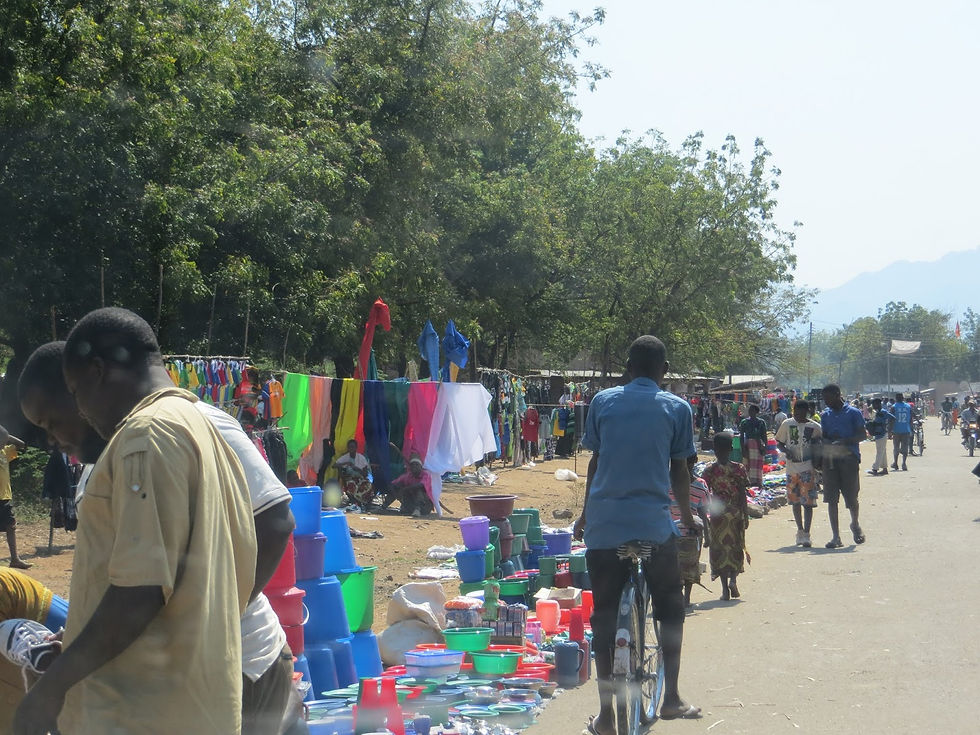Ndamera
- kwankew

- Aug 7, 2013
- 3 min read
Today I traveled to Ndamera with a group of MSF staffers including my MSF mentors and a Ministry of Health (MOH) mentor. This was my first field day. Half of Malawi is engulfed by Mozambique in the southern region. Ndamera and Lulwe are two regions that are southernmost of Nsanje. As soon as we left Nsanje town the tarmac road disappeared to be followed by compact dirt road, bumpy at times and crossing several dry riverbeds. Many of the bridges seemed to have sunk into the beds. There were scattered red-brick or stucco houses with tin or thatch roofing. After about fifteen minutes we reached Mbenji Health Facility and dropped off a few staff. The center of town had a short tarmac road, narrow to begin with thin slivers of dirt sidewalks which were all occupied with sellers of produce, tomatoes, sweet potatoes, second-hand clothing mainly from America or kaunjika, new clothes of different African football teams and European teams, all spilling into the sides of the road, making the road even narrower. This reminded me of Freetown in Sierra Leone or La Paz in Bolivia where the sidewalks were taken by the vendors and pedestrians spilled into the main roadway running the danger of being run over by vehicles.

We were besieged by a herd of cows which looked a little bewildered trying to maneuver around the cruiser. Their big wide and innocent eyes looked around patiently. The land is dry but not as dry as in South Sudan, they could still find some meager pickings in the lowlands.
We passed by a defunct railway track, the driver who is from this region could not tell me when it was last functioning. The land is overgrown with weeds, I could discern no crops at least from the road. I was told tomatoes are grown in the hills. Mango trees are bearing small fruits now and soon we will be able to have mangoes. Naked baobab trees look prominent among trees that are all green with leaves.
Ndamera Health Center was funded by UNHCR, I could not ascertain when it was built. It looks old and decrepit. Two taps have labels next to them stating they are not functional, one is bone dry and the other drips and is tied with rubber tubing to try in vain to stop the drip. The maternity section is on one side with antenatal, labor and delivery and postnatal care units. The outpatient department is in the center and the HIV counseling room and other unusable rooms on the other side. At the back is a huge tent which was set up a couple of years ago for the cholera outbreak which happens periodically when the river floods.


The HIV treatment room is in a new building with many rooms but only one large room is being used to see patients and an adjoining room to register, weigh and give patients their master patient card. Outside there is a waiting room. On the day we visited there were a medical assistant and a nurse seeing the patients. Most of the patients were women and babies, only a few men attended the clinic. Mozambique being only 5 Km away, most patients came from there. They were dressed quite warmly from head to ankles and most did not wear shoes. I wonder how their feet feel where the temperature soars.
As we drove towards the town of Nsanje in the early afternoon, the mountains in the distance looked hazy and hot. The baobab tree looked fried but still dignified in its naked state.








Comments